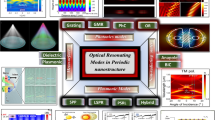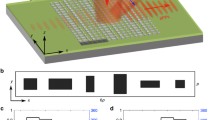Abstract
Photonic structures with optical resonances beyond a single controllable mode are strongly desired for enhancing light-matter interactions and bringing about advanced photonic devices. However, the realization of effective multimodal photonic structures has been restricted by the limited tunable range of mode manipulation, the spatial dispersions of electric fields or the polarization-dependent excitations. To overcome these limitations, we create a dualmode metasurface by integrating the plasmonic surface lattice resonance and the gap plasmonic modes; this metasurface offers a widely tunable spectral range, good overlap in the spatial distribution of electric fields, and polarization independence of excitation light. To show that such dual-mode metasurfaces are versatile platforms for enhancing light-matter interactions, we experimentally demonstrate a significant enhancement of second-harmonic generation using our design, with a conversion efficiency of 1–3 orders of magnitude larger than those previously obtained in plasmonic systems. These results may inspire new designs for functional multimodal photonic structures.

摘要
克服光子结构中只有单个可控共振模式的问题对于增强光- 物相互作用和实现先进光子器件具有重要意义. 然而, 由于模式调 控的可调范围有限、电场增强的空间分布差异或模式激发具有偏 振依赖等因素的限制, 构建可调的多共振的光子结构一直受到限 制. 为了克服这些局限, 本文将等离激元表面晶格共振模式和间隙 等离激元模式相结合, 构建了一种双共振超表面体系, 该体系具有 覆盖可见光到近红外波段的光谱可调范围以及良好的电场增强空 间重叠性的特点. 为了证明该双共振超构表面的优势, 我们研究了 该体系的二次谐波效应, 发现该双共振超构表面的二次谐波转化 效率比以往等离激元体系效率高1–3个数量级. 以上结果显示, 我 们的发现为制备基于多模式共振光子结构的功能化器件提供了一 个有效方案.
Similar content being viewed by others
References
Krasavin AV, Ginzburg P, Zayats AV. Free-electron optical non-linearities in plasmonic nanostructures: A review of the hydrodynamic description. Laser Photonics Rev, 2018, 12: 1700082
Wu B, Wang PF, Qiu YH, et al. Enhanced second-harmonic generation of asymmetric Au@CdSe heterorods. Sci China Mater, 2020, 63: 1472–1479
Zhang X, Cao QT, Wang Z, et al. Symmetry-breaking-induced nonlinear optics at a microcavity surface. Nat Photon, 2019, 13: 21–24
Bao Y, Yu Y, Xu H, et al. Full-colour nanoprint-hologram synchronous metasurface with arbitrary hue-saturation-brightness control. Light Sci Appl, 2019, 8: 95
Xue J, Zhou ZK, Lin L, et al. Perturbative countersurveillance metaoptics with compound nanosieves. Light Sci Appl, 2019, 8: 101
Panoiu NC, Sha WEI, Lei DY, et al. Nonlinear optics in plasmonic nanostructures. J Opt, 2018, 20: 083001
Li GC, Zhang Q, Maier SA, et al. Plasmonic particle-on-film nanocavities: a versatile platform for plasmon-enhanced spectroscopy and photochemistry. Nanophotonics, 2018, 7: 1865–1889
Liu SD, Leong ESP, Li GC, et al. Polarization-independent multiple Fano resonances in plasmonic nonamers for multimode-matching enhanced multiband second-harmonic generation. ACS Nano, 2016, 10: 1442–1453
Chikkaraddy R, de Nijs B, Benz F, et al. Single-molecule strong coupling at room temperature in plasmonic nanocavities. Nature, 2016, 535: 127–130
Karimpour S, Noori M. All-angle self-collimation-based invisibility cloaking in 2D square lattice photonic crystals. Annalen Der Physik, 2020, 532: 2000026
Tang Y, Liu Z, Deng J, et al. Nano-Kirigami metasurface with giant nonlinear optical circular dichroism. Laser Photonics Rev, 2020, 14: 2000085
Zhang T, Che Y, Chen K, et al. Anapole mediated giant photothermal nonlinearity in nanostructured silicon. Nat Commun, 2020, 11: 3027
Bao Y, Jiang Q, Kang Y, et al. Enhanced optical performance of multifocal metalens with conic shapes. Light Sci Appl, 2017, 6: e17071
Uppu R, Eriksen HT, Thyrrestrup H, et al. On-chip deterministic operation of quantum dots in dual-mode waveguides for a plug-and-play single-photon source. Nat Commun, 2020, 11: 3782
Peruzzo A, Laing A, Politi A, et al. Multimode quantum interference of photons in multiport integrated devices. Nat Commun, 2011, 2: 224
Fikouras AH, Schubert M, Karl M, et al. Non-obstructive intracellular nanolasers. Nat Commun, 2018, 9: 4817
Kravets VG, Schedin F, Jalil R, et al. Singular phase nano-optics in plasmonic metamaterials for label-free single-molecule detection. Nat Mater, 2013, 12: 304–309
Jaffe T, Sorias O, Gal L, et al. Doubly resonant nanoantennas on diamond for spatial addressing of spin states. Nano Lett, 2017, 17: 4217–4222
Weber N, Protte M, Walter F, et al. Double resonant plasmonic nanoantennas for efficient second harmonic generation in zinc oxide. Phys Rev B, 2017, 95: 205307
Liu SD, Yue P, Zhu MQ, et al. Restoring the silenced surface second-harmonic generation in split-ring resonators by magnetic and electric mode matching. Opt Express, 2019, 27: 26377–26391
Ciracì C, Hill RT, Mock JJ, et al. Probing the ultimate limits of plasmonic enhancement. Science, 2012, 337: 1072–1074
Li GC, Zhang YL, Lei DY. Hybrid plasmonic gap modes in metal film-coupled dimers and their physical origins revealed by polarization resolved dark field spectroscopy. Nanoscale, 2016, 8: 7119–7126
Li GC, Zhang YL, Jiang J, et al. Metal-substrate-mediated plasmon hybridization in a nanoparticle dimer for photoluminescence line-width shrinking and intensity enhancement. ACS Nano, 2017, 11: 3067–3080
Zou S, Janel N, Schatz GC. Silver nanoparticle array structures that produce remarkably narrow plasmon lineshapes. J Chem Phys, 2004, 120: 10871–10875
Kravets VG, Schedin F, Grigorenko AN. Extremely narrow plasmon resonances based on diffraction coupling of localized plasmons in arrays of metallic nanoparticles. Phys Rev Lett, 2008, 101: 087403
Auguié B, Barnes WL. Collective resonances in gold nanoparticle arrays. Phys Rev Lett, 2008, 101: 143902
Farjadpour A, Roundy D, Rodriguez A, et al. Improving accuracy by subpixel smoothing in the finite-difference time domain. Opt Lett, 2006, 31: 2972–2974
Palik ED. Handbook of Optical Constants of Solids. San Diego: Academic Press, 1998
Celebrano M, Wu X, Baselli M, et al. Mode matching in multi-resonant plasmonic nanoantennas for enhanced second harmonic generation. Nat Nanotech, 2015, 10: 412–417
Liu Z, Ye J. Highly controllable double Fano resonances in plasmonic metasurfaces. Nanoscale, 2016, 8: 17665–17674
Zeng Y, Qian H, Rozin MJ, et al. Enhanced second harmonic generation in double-resonance colloidal metasurfaces. Adv Funct Mater, 2018, 28: 1803019
Rodrigo D, Tittl A, John-Herpin A, et al. Self-similar multi-resonant nanoantenna arrays for sensing from near- to mid-infrared. ACS Photonics, 2018, 5: 4903–4911
Aouani H, Navarro-Cia M, Rahmani M, et al. Multiresonant broadband optical antennas as efficient tunable nanosources of second harmonic light. Nano Lett, 2012, 12: 4997–5002
Länk NO, Verre R, Johansson P, et al. Large-scale silicon nanophotonic metasurfaces with polarization independent near-perfect absorption. Nano Lett, 2017, 17: 3054–3060
Aydin K, Ferry VE, Briggs RM, et al. Broadband polarization-independent resonant light absorption using ultrathin plasmonic super absorbers. Nat Commun, 2011, 2: 517
Butet J, Brevet PF, Martin OJF. Optical second harmonic generation in plasmonic nanostructures: From fundamental principles to advanced applications. ACS Nano, 2015, 9: 10545–10562
Ding SJ, Zhang H, Yang DJ, et al. Magnetic plasmon-enhanced second-harmonic generation on colloidal gold nanocups. Nano Lett, 2019, 19: 2005–2011
Zhang S, Li GC, Chen Y, et al. Pronounced Fano resonance in single gold split nanodisks with 15 nm split gaps for intensive second harmonic generation. ACS Nano, 2016, 10: 11105–11114
Liu S, Vabishchevich PP, Vaskin A, et al. An all-dielectric meta-surface as a broadband optical frequency mixer. Nat Commun, 2018, 9: 2507
Koshelev K, Kruk S, Melik-Gaykazyan E, et al. Subwavelength dielectric resonators for nonlinear nanophotonics. Science, 2020, 367: 288–292
Wang Y, Wei D, Zhu Y, et al. Conversion of the optical orbital angular momentum in a plasmon-assisted second-harmonic generation. Appl Phys Lett, 2016, 109: 081105
Kim KH, Park BH, Tu Y, et al. Polarization-sensitive optical frequency domain imaging based on unpolarized light. Opt Express, 2011, 19: 552–561
Hisano K, Ota M, Aizawa M, et al. Single-step creation of polarization gratings by scanning wave photopolymerization with unpolarized light. J Opt Soc Am B, 2019, 36: D112–118
Lindfors K, Priimagi A, Setälä T, et al. Local polarization of tightly focused unpolarized light. Nat Photon, 2007, 1: 228–231
Törmä P, Barnes WL. Strong coupling between surface plasmon polaritons and emitters: a review. Rep Prog Phys, 2015, 78: 013901
Christ A, Zentgraf T, Tikhodeev SG, et al. Controlling the interaction between localized and delocalized surface plasmon modes: Experiment and numerical calculations. Phys Rev B, 2006, 74: 155435
Farhang A, Bigler N, Martin OJF. Coupling of multiple LSP and SPP resonances: interactions between an elongated nanoparticle and a thin metallic film. Opt Lett, 2013, 38: 4758–4761
Yang J, Sun Q, Ueno K, et al. Manipulation of the dephasing time by strong coupling between localized and propagating surface plasmon modes. Nat Commun, 2018, 9: 4858
Shi X, Ueno K, Oshikiri T, et al. Enhanced water splitting under modal strong coupling conditions. Nat Nanotech, 2018, 13: 953–958
Zhou ZK, Liu J, Bao Y, et al. Quantum plasmonics get applied. Prog Quantum Electron, 2019, 65: 1–20
Acknowledgements
This work was supported by the National Key R&D Program of China (2016YFA0301300), the National Natural Science Foundation of China (11974437 and 91750207), the Key-Area Research and Development Program of Guangdong Province (2018B030329001), Guangdong Special Support Program (2017TQ04C487), Guangdong Natural Science Funds for Distinguished Young Scholars (2017B030306007), Guangdong Natural Science Funds (2020A0505140004), Pearl River S&T Nova Program of Guangzhou (201806010033), the Open Fund of IPOC (BUPT) (IPOC2019A003), and the Fundamental Research Funds for the Central Universities (20lgzd30).
Author information
Authors and Affiliations
Contributions
Zhou ZK conceived the idea of the research. Zhou ZK, Lin L and Xue J designed the research processes. Lin L and Xue J conducted most of the experiments and simulations. Xu H participated in the fabrication process. Zhao Q, Zhang W and Zheng Y performed the simulation of modal strong coupling. Zhou ZK, Wu L, Lin L and Xue J analyzed the results and wrote the manuscript. All authors contributed to the discussion of the manuscript.
Corresponding author
Additional information
Limin Lin is currently a master candidate at Sun Yat-sen University. She received her B.Eng. (majored in information engineering) from the Department of Optoelectronic Engineering, Jinan University in 2018. Her master research focuses on optical metamaterials and their nonlinear device applications.
Jiancai Xue received his PhD degree (majored in optics) and BSc degree (majored in optical information science and technology) from Sun Yat-sen University in 2018 and 2013, respectively. He has been a postdoctoral fellow at Sun Yat-sen University since 2018. His research focuses on nanophotonics, including plasmonic devices, metasurfaces and functional nano-structures
Zhang-Kai Zhou received his PhD degree in physics from Wuhan University in 2011 and joined Sun Yat-sen University in the same year. He is currently a professor of physics, as well as the deputy dean of the Department of Optics and Optical Engineering, School of Physics, Sun Yatsen University. His research interests mainly focus on the field of meta-optics, including quantum plasmonics, optical metamaterials, and functional nanodevices based on metasurfaces.
Conflict of interest
The authors declare no conflict of interest.
Rights and permissions
About this article
Cite this article
Lin, L., Xue, J., Xu, H. et al. Integrating lattice and gap plasmonic modes to construct dual-mode metasurfaces for enhancing light–matter interaction. Sci. China Mater. 64, 3007–3016 (2021). https://doi.org/10.1007/s40843-021-1686-2
Received:
Accepted:
Published:
Issue Date:
DOI: https://doi.org/10.1007/s40843-021-1686-2




